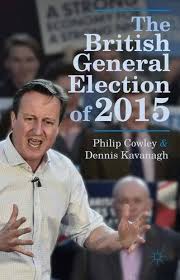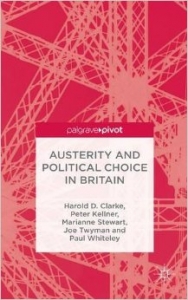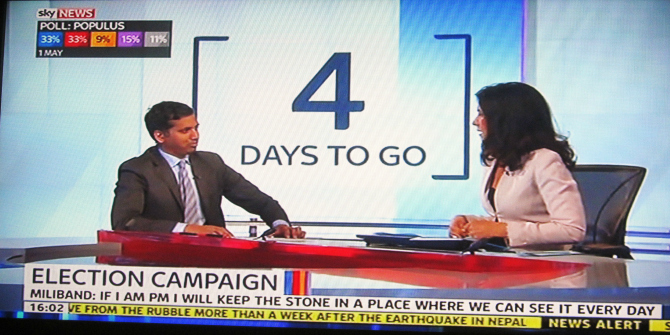The Long Read: How the Polls and the Media Delivered Cameron’s Unexpected Victory by Ron Johnston
The Long Read: How the Polls and the Media Delivered Cameron’s Unexpected Victory
As reports into why Labour lost the 2015 British general election and why the opinion polls got the result so wrong emerge, two recently published books present very different academic analyses of the run-up to that contest and its outcome. Ron Johnston reviews their relative merits.
The British General Election of 2015. Philip Cowley and Dennis Kavanagh. Palgrave Macmillan. 2015.
Austerity and Political Choice in Britain. Harold Clarke, Peter Kellner, Marianne C Stewart, Joe Twyman and Paul Whiteley. Palgrave Macmillan. 2015.

 The 2015 British general election has already entered history for producing one of the ‘shock results’ of recent decades (like 1970 and 1992). An outright win for one party was very much unexpected; for months, even years, the media and academic ‘experts’ were predicting a hung Parliament, based on a massive volume of opinion polling. Indeed, some thought Labour would be the largest party in whatever post-election coalition was formed. Instead, they got a Conservative (small) majority government: the first time a party in power had increased both its vote and seat share for many decades.
The 2015 British general election has already entered history for producing one of the ‘shock results’ of recent decades (like 1970 and 1992). An outright win for one party was very much unexpected; for months, even years, the media and academic ‘experts’ were predicting a hung Parliament, based on a massive volume of opinion polling. Indeed, some thought Labour would be the largest party in whatever post-election coalition was formed. Instead, they got a Conservative (small) majority government: the first time a party in power had increased both its vote and seat share for many decades.
Understanding how that happened continues to be the focus of much public attention, and the first of the books reviewed here contributes substantially to that effort. The British General Election of 2015 is the latest in a distinguished line of volumes that began in 1945, the eleventh with Dennis Kavanagh as co-author and the second for Philip Cowley. They have continued the tradition of providing an excellent and lively analysis of what happened in the election and why.
A highly readable and informative account, much of the book follows the established pattern, with early chapters on recent political history and the country’s three largest parties’ changing fortunes during the 2010-15 Parliament. It focuses particularly on the stresses and strains of a five-year-long coalition involving two parties that differed substantially on many policy issues, alongside those of the defeated Labour party seeking to re-establish its credibility but failing to distance itself from the coalition’s continuing success in presenting the Blair and Brown governments as profligate and responsible for the austerity policies deemed ‘necessary’ (what later became the ‘long-term economic plan’) to end deficit budgeting and reduce the national debt. For the first three of those five years, the ‘plan’ appeared to be failing, but Labour, under a new leader who never gained substantial voter approval, failed to distance itself from the past and establish itself as credible once again to manage the country’s economy.
Here the narrative deviates from the standard format with a chapter on ‘The Long and Short of the SNP Breakthrough’ by Richard Rose and Mark Shephard, reflecting the importance of the 2014 referendum that rejected Scottish independence and led to the subsequent substantial rise in the Scottish National Party’s popularity. The next two chapters deal with how the parties each prepared for the election and their national campaigns, followed by one on election night itself. Expectations were overturned when the polls closed and the national exit poll indicated that the Conservatives would be by far the largest party – updated as the constituency results came in to a (correct) prediction that they would have a small majority. David Cameron ditched his loser’s concession speech; Ed Miliband had to give one instead, having anticipated declaring himself the winner and starting negotiations over a coalition. Miliband resigned, as did Nick Clegg, leader of the coalition’s junior partner, the Liberal Democrats, which lost two-thirds of its votes and 86 percent of its seats.

Image Credit: General Election 2015 (David Holt)
Discussion of the failure of virtually all of the opinion polls merits a separate chapter. The next is on the constituency campaigns with their focus on targeted seats, especially those in England held by the Lib Dems, most of which fell to a Conservative onslaught of mailings threatening that a Lib Dem vote could let in a Miliband-led coalition sustained (even held to ransom?) by the SNP – a party that wished to break up the UK. It illustrates just how much this component of election campaigns has changed over recent contests, especially where money is plentiful. Merely identifying a party’s supporters and encouraging them to turn out is no longer sufficient: Labour did plenty of that, but little of the sophisticated targeted mailings undertaken by the Conservatives. There are chapters on the broadcast and press media (with considerable attention on the fraught negotiations leading to the various ‘debates’), and on the candidates’ characteristics. There is a brief concluding chapter and the usual statistical appendices and analysis of the results involving (as in every volume since 1979) John Curtice, paired (as in 2010) with Stephen Fisher and Robert Ford.
The book, unsurprisingly, does not differ from the widespread view that Labour lost because it was unable to dispel the belief, pressed home time and again by the Prime Minister and the Chancellor, that it was responsible for the financial crash of 2007-08 and the austerity programme put in place as a consequence; because it had an unattractive leader; and because it would probably have to take power in some sort of arrangement with the SNP. But its final chapter stresses – an argument now being widely taken up – that the campaign and the outcome might have been very different if the polls had been accurate, not just in the weeks before the election but in the previous months and even years.
It now seems very likely that the polls were over-predicting Labour’s vote share and under-predicting the Conservatives’ since 2013 because of unrepresentative (and, as a consequence, inadequately weighted) sample designs. If the campaign had taken place in the knowledge that the Conservatives had a substantial poll lead, the issues debated may have been very different: the Conservative policies (several uncosted because they were expecting to be in coalition again and could blame their partners for the failure to implement them) would have attracted much more attention and the threat of a Labour-SNP coalition may not have loomed sufficiently to allow for Tory attacks on Lib Dem-held seats. The media’s obsession with the polling companies’ false prophecies dominated public discourse over the pre-election months: so were they responsible for the outcome? In the medium and longer term, answers to that question may have a major impact on aspects of the UK’s political and electoral practice.
The 2015 result can be summarised in a few main facts: there was little change in the overall popularity of the Conservative and Labour parties between 2010 and 2015; few seats changed hands between them; the Lib Dem vote collapsed, from which the Conservatives benefited most; the SNP routed Labour and the Lib Dems in Scotland; and although UKIP and the Greens substantially increased their vote shares, they each got only one MP – illustrating how unkind the UK’s electoral system is to parties with lots of votes in the wrong places.
That quick summary emerges clearly from Cowley and Kavanagh’s book, but not from the other reviewed here. Austerity and Political Choice in Britain is co-authored by three of the leaders of the 2001, 2005 and 2010 British Election Studies, joined in this book by two of their pollsters from YouGov. Harold Clarke, Paul Whiteley and Marianne C. Stewart have developed two main arguments over the last fifteen years: firstly, that face-to-face surveys are both expensive and ineffective and should be replaced by frequent surveys which allow trends in opinion and behaviour to be monitored, for which online surveys are effective and relatively inexpensive; and secondly, that the traditional sociological model of British voting behaviour based on social class is obsolete and should be replaced by valence theories. Their short, expensive book operates on those foundations: much is based on regular internet surveys over the period and the analyses focus entirely on valence models, according to which voters determine which party to support on the basis of evaluations of its past performance and proposed policies regarding the major issues of the day, with the economy dominating such evaluations. Rather than expend time and energy evaluating performance and policies, however, many voters use a simple heuristic – which party leader they prefer.
The book’s first chapters partly mimic in miniature those of Cowley and Kavanagh, using polling data to chart changing attitudes. These clearly show a change in the Conservatives’ fortunes after 2013 when they abandoned their goal of clearing the deficit by 2015 and the economic indicators – unemployment, economic growth, etc – turned in their favour. This useful material sets the context for its chapter on ‘Choosing to Vote and Choosing a Party’, deploying valence models to explore variations in both turnout and partisan choice at the individual level. The authors conclude that their multivariate statistical analyses ‘fit well with the argument that a triumvirate of valence politics variables – reactions to economic conditions, leader images and partisan identification – exerted major effects on voting behaviour in 2015’ (119). Valence politics variables had the ‘strongest explanatory power’ in accounting statistically for support for all six main parties, and ‘socio-demographics’ – those representing the traditional social class model – ‘the weakest’. This conclusion is partly a function of the analytical method, however: respondents’ socio-demographic characteristics are ‘held constant’, but they may be co-linear with valence attitudes (lower-status people may have preferred Miliband, whereas Labour identifiers almost certainly did; older people, especially males, may have preferred UKIP). We know that people with particular attitudes voted differently, but not who they were: were those content with their economic situations evenly spread through the population?
And where were they? A further chapter seeks an explanation for the election outcome. But many important geographical variations in the translation of votes into seats are totally ignored; the appendix to the Cowley and Kavanagh book is much more informative and accessible to a general reader.
Valence models have added much to our appreciation of recent British elections, and the authors are undoubtedly correct regarding the importance of leader images and their positions on the main campaign issues. But an election outcome – especially that of 2015 – calls for a much more nuanced analysis than this latter book’s relatively narrow focus. It is designed for the ‘interested reader’, but that stereotyped individual will get much more from Cowley and Kavanagh.
—
Note: this post originally appeared on the LSE Review of Books. It represents the views of the author and not those of Democratic Audit or the LSE. Please read our comments policy before posting.
—
Ron Johnston is a professor in the School of Geographical Sciences at the University of Bristol; he was formerly a Pro-Vice-Chancellor at the University of Sheffield and Vice-Chancellor at the University of Essex. Read more reviews by Ron Johnston.





 Democratic Audit's core funding is provided by the Joseph Rowntree Charitable Trust. Additional funding is provided by the London School of Economics.
Democratic Audit's core funding is provided by the Joseph Rowntree Charitable Trust. Additional funding is provided by the London School of Economics.
The Long Read: How the Polls and the Media Delivered Cameron’s Unexpected Victory by Ron Johnston https://t.co/t2wjStgYfd
How the Polls and the Media Delivered Cameron’s Unexpected Victory by Ron Johnston https://t.co/RV25tJKgGa
How the Polls and the Media Delivered Cameron’s Unexpected Victory by Ron Johnston https://t.co/I56BZq8fUd
The Long Read: How the Polls and the Media Delivered Cameron’s Unexpected Victory by Ron Johnston https://t.co/G1fpeiHOPP
The Long Read: How the Polls and the Media Delivered Cameron’s Unexpected Victory by Ron Johnston https://t.co/0FseQa34FL
The Long Read: How the Polls and the Media Delivered Cameron’s Unexpected Victory by Ron Johnston https://t.co/m2hsnn2psb
The Long Read: How the Polls and the Media Delivered Cameron’s Unexpected Victory by Ron Johnston – Democratic… https://t.co/fKSXPecFdT
The Long Read: How the Polls and the Media Delivered Cameron’s Unexpected Victory by… https://t.co/Q5kowgJLOK https://t.co/iUrh5b0Maq